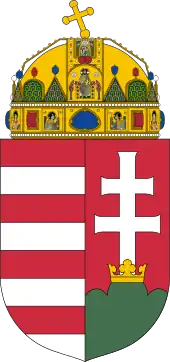Pannonia
Pannonia (/pəˈnoʊniə/, Latin: [panˈnɔnia]) was a province of the Roman Empire bounded on the north and east by the Danube, coterminous westward with Noricum and upper Italy, and southward with Dalmatia and upper Moesia. Pannonia was located in the territory that is now western Hungary, western Slovakia, eastern Austria, northern Croatia, north-western Serbia, northern Slovenia, and northern Bosnia and Herzegovina.
| Provincia Pannonia | |
|---|---|
| 8 AD–433 AD | |
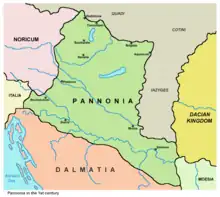 Province of Pannonia in the first century AD | |
| Capital | Carnuntum,[1] Sirmium,[2] Savaria,[3] Aquincum,[4] Poetovio[5] or Vindobona[6] |
| Demonym | Pannonian |
| History | |
| Historical era | Classical antiquity |
• Established via separation from Illyricum | 8 AD |
| 433 AD | |
Name
Julius Pokorny believed the name Pannonia is derived from Illyrian, from the Proto-Indo-European root *pen-, "swamp, water, wet" (cf. English fen, "marsh"; Hindi pani, "water").[7]
Pliny the Elder, in Natural History, places the eastern regions of the Hercynium jugum, the "Hercynian mountain chain", in Pannonia and Dacia (now Romania).[8] He also gives us some dramaticised description[9] of its composition, in which the proximity of the forest trees causes competitive struggle among them (inter se rixantes). He mentions its gigantic oaks.[10] But even he—if the passage in question is not an interpolated marginal gloss—is subject to the legends of the gloomy forest. He mentions unusual birds, which have feathers that "shine like fires at night". Medieval bestiaries named these birds the Ercinee. The impenetrable nature of the Hercynia Silva hindered the last concerted Roman foray into the forest, by Drusus, during 12–9 BC: Florus asserts that Drusus invisum atque inaccessum in id tempus Hercynium saltum (Hercynia saltus, the "Hercynian ravine-land")[11] patefecit.[12]
Background
Geography and economy
In the Early Iron Age, Transdanubia was inhabited by the Pannonians, a subgroup of the Illyrians, and the Great Hungarian Plain by peoples of Scythic culture. The Celts invaded in the Late Iron Age. Gallo-Roman historian Pompeius Trogus tells us that the Celts met with heavy resistance from the locals and couldn't overrun the southern part of Transdanubia. Some tribes advanced as far as Delphi, with the Scordisci settling in Syrmia (279 BC) upon forced to withdraw. The Celts founded many villages. Those that held prominent economic significance developed into oppida.[13] As part of a new migration wave at the end of the 2nd century BC, the Boii left Northern Italy and established themselves as an important power at the Danube.[14]
Pannonia was connected to the Italian Peninsula by trade since the 2nd millennium BC. Amber from Jutland and East Prussia arrived to there through Transdanubia. Later in the 1st millennium BC, industrial products of the Veneti and Etruscans, and from the Este culture were brought here.[15] The Celtic invasion broke trade between the inhabitants of Italy and the Germanic peoples through Transdanubia. There was no big rupture with the inhabitants of Transdanubia, however. Aes signatum ingots were in use in Pannonia as long as the 1st century BC.[15] Independent tribes minted their own coins with the faces of their leaders. These were at first modeled on Macedonian, and later Roman currency.[13] For one and a half century prior to the Roman invasion, the Celts and the Romans were in stable trade relations. Roman merchants brought industrial products in exchange for slaves and raw materials.[16]
Developments leading to the Roman occupation
The strengthening of the empire necessarily led to the annexation of new territories.[17] This process was slow but enthused by the ideology of Pax Romana.[18] In the aftermath of the Second Punic War, Rome solidified control over the southern part of Illyria and looked to link it up with Northern Italy by land. This goal required expansion toward modern-day Hungary.[19] In 183 BC, the Senate established the colonia of Aquileia to make Pannonia economically closer. Later, the rich Aquileian lords played a big part in the region's economy.[20] The hazard caused by the tribe of the Scordisci was an important reason for the conquest of the area.[18] Besides pillaging, their incursions slowed the seizure of the Balkans.[17] The Dardani and Thracians posed similar threats.[18] The Macedonians urged them to raid Pannonia and Perseus reached an alliance with them.[18] The Scordisci, in alliance with the Dalmatae were in armed conflict with the Romans as early as 156 BC and 119 BC. In both wars, the Romans failed to take Siscia (now Sisak, Croatia), which laid in a key position.[14] After these setbacks, Rome turned instead towards Noricum which had both iron and silver mines.[21] During the Mithridatic Wars, Mithridates VI Eupator planned to cross Pannonia to attack Italy.[22]
Roman expansion here paused for a time and holdings at the Danube were lost in the turmoil caused by the Social War. Other problems, such as the population shift related to the Cimbri and the strong resistance of the Iapydes kept back the advancement of this relatively less important front line.[19] In the early 1st century BC, the Dacians emerged as a new dominant power. While their hold on the area between the Danube and the Tisza was loose, they had considerable influence in the territories beyond.[22] In 88 BC, Scipio Asiaticus (consul 83 BC) defeated the Scordisci so badly that they retreated to the eastern part of Syrmia.[23][24] Taking advantage of this, the Dacian king Burebista vanquished them, and subsequently the Boii and the Taurisci too. Thanks to the ebb of these entities, several local tribes regained their independence and influence.[25][24] Curio Burbuleius's army reached the Danube probably through the Morava Valley.[18] But even during the life of Julius Caesar, the conquest of Gaul came first and the unruly Dalmatae couldn't be dealt with due to the conflict with Pompey the Great.[26]
Roman conquest
The tribes of the Pannonians, to which no army of the Roman people had ever penetrated before my principate, having been subdued by Tiberius Nero who was then my stepson and my legate, I brought under the sovereignty of the Roman people, and I pushed forward the frontier of Illyricum as far as the bank of the river Danube. An army of Dacians which crossed to the south of that river was, under my auspices, defeated and crushed, and afterwards my own army was led across the Danube and compelled the tribes of the Dacians to submit to the orders of the Roman people.
Octavian maintained large armies to keep the balance with Mark Antony, so to put a better face on his activity, he pursued a foreign policy of expanding Roman dominions northward.[28] Pannonia was driven into conflict due to the support of the Dalmatae in their strife against Rome.[29] The tribes north of the Drava didn't participate in nor this, nor the subsequent fights.[21] In 35 BC, Octavian led a campaign against the Iapydes and the Pannonians,[25] in which he captured Siscia in a month-long siege.[24] A large part of the Sava valley thus came under occupation. This was in accordance with Caesar's plan not realized due to his assassination, but it appears Octavian didn't intend to use the newly acquired land as a base for an invasion of Dacia, instead wanting to establish closer contact with Dalmatia.[22]
In 16 BC, Augustus conquered the Kingdom of Noricum.[30] In 15 BC, the future-emperor Tiberius attacked the Scordisci[24][25] and forced them to become Rome's allies.[24] In 14 BC, the Pannonians rose up. Marcus Agrippa was sent to the region after another rebellion in 13 BC.[24][25]
After his death the following year, the campaign was taken over by Tiberius,[24][25] who celebrated his triumph in 11 BC. The province of Illyricum was established between the Sava and the Adriatic Sea.[25] In 10 BC, Tiberius returned to quell a new uprising of the Pannonians and Dalmatae. After winning in 9 BC, he sold the youth of the Breuci and Amantini as slaves in Italy and held an ovation.[31] His operations between 12 and 9 BC included constant expeditions into territories north of the Drava and certainly brought the whole Transdanubia under Roman control even though there's no direct evidence to that.[32]
Pannonia was invaded by the Dacians in 10 BC. The Romans launched campaigns through the Danube in order to secure the very threatened new land. Lucius Domitius Ahenobarbus's (consul 16 BC) operation in 1 AD extended as far as the Elbe. Locally more important was the offensive of Marcus Vinicius against the tribes on the east of the Danube Bend, showing an intent of "monopolizing" the Northern Transdanubian region politically.[24] Only the Thracian kingdom remained a client state.[33] The Dacian king Cotiso died in 9 BC, maybe in war with Augustus.[34]
Roman rule
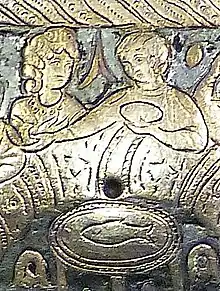


Consolidation and establishment of administration
In 7 AD, the Great Illyrian Revolt erupted as the subdued population of Illyricum rose up against Roman rule. The rebels were eventually defeated after a hard-fought campaign lasting 2 years led by Germanicus and future-emperor Tiberius.[35]
In 8 AD, Illyricum was divided into Dalmatia (initially called Illyricum Superius) and Pannonia (initially Illyricum Inferius).[29]
The foremost objective of Rome in the region continued to be the conclusion of the barbarian conflicts. Plautius Silvanus moved as many as 100,000 barbarians from Pannonia to Moesia. During the significant governorship of Tampius Flavianus, Roman currency began to circle in the Barbaricum and the first stage of the consolidation of the Central Danubian limes took place. Also, 50,000 barbarians may have been settled inside and the province's administration may have been organized.[36]
Under the Antonines
Due to the proximity of hostile barbarian tribes, many fortifications were built on the border and large number of legionaries and auxiliaries were stationed in the region.[35]
Some time between the years 102 and 107, between the first and second Dacian wars, Trajan divided the province into Pannonia Superior (western part with the capital Carnuntum), and Pannonia Inferior (eastern part with the capitals in Aquincum and Sirmium[37]). According to Ptolemy, these divisions were separated by a line drawn from Arrabona in the north to Servitium in the south; later, the boundary was placed further east. The whole country was sometimes called the Pannonias (Pannoniae).
The Sarmatians
The province of Pannonia was threatened from the east by the Scythic Sarmatians. During the conquest of Transdanubia, Sarmatian peoples, most notably the Iazyges occupied the Danube–Tisza Interfluve, vassallizing the Dacian-Celtic elements in the area and trading with both the Romans and other Celts. This was beneficial for the Roman Empire because the Sarmatians counterbalanced Dacia. Nonetheless, their looting campaigns through the frozen Danube[38] resulted in large amounts of soldiers being drawn to that segment of the border in the 180s. In the 190s, guard posts, bridgeheads, earth forts and later stone forts were constructed at Aquincum, Albertfalva, Nagytétény, Adony, Százhalombatta, Dunaújváros and other settlements.[39]
Marcomannic Wars
The one and a half century of relative peacefulness in the province was ended by an invasion of the Marcomanni, Quadi and Iazyges during the reign of Marcus Aurelius. The struggle was made even more difficult by the ravaging Antonine Plague, in which the emperor himself died at Vindobona, Pannonia Superior.[40] Marcus Aurelius constructed the limes.[41]
Crisis and stabilisation
After Marcus Aurelius, Commodus continued to fight along the limes, but governed the empire negligently. External attacks made possible Septimius Severus's ascension to the throne, who was governor of Pannonia Superior. Thanks to this soldier-emperor, peace returned for half a century. After the fall of the Severan dynasty, internal and external conflict restarted. The ambient barbarian peoples were able to penetrate in multiple parts of the border. In 260 Roxolani invaded the province.[41]
Administration
Pannonia Superior was under the consular legate, who had formerly administered the single province, and had three legions under his control. Pannonia Inferior was at first under a praetorian legate with a single legion as the garrison; after Marcus Aurelius, it was under a consular legate, but still with only one legion. The frontier on the Danube was protected by the establishment of the two colonies Aelia Mursia and Aelia Aquincum by Hadrian.
Under Diocletian, a fourfold division of the country was made:
- Pannonia Prima in the northwest, with its capital in Savaria, it included Pannonia Superior and the major part of Central Pannonia between the Raba and Drava,
- Pannonia Valeria in the northeast, with its capital in Sopianae, it comprised the remainder of Central Pannonia between the Raba, Drava and Danube,
- Pannonia Savia in the southwest, with its capital in Siscia,
- Pannonia Secunda in the southeast, with its capital in Sirmium
Diocletian also moved parts of today's Slovenia out of Pannonia and incorporated them in Noricum. In 324 AD, Constantine I enlarged the borders of Roman Pannonia to the east, annexing the plains of what is now eastern Hungary, northern Serbia and western Romania up to the limes that he created: the Devil's Dykes.
In the 4th-5th century, one of the dioceses of the Roman Empire was known as the Diocese of Pannonia. It had its capital in Sirmium and included all four provinces that were formed from historical Pannonia, as well as the provinces of Dalmatia, Noricum Mediterraneum and Noricum Ripense.
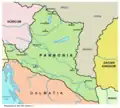 Pannonia in the 1st century
Pannonia in the 1st century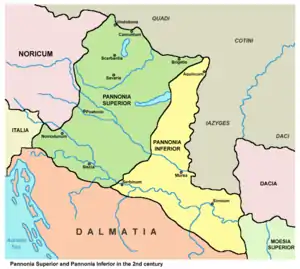 Pannonia in the 2nd century
Pannonia in the 2nd century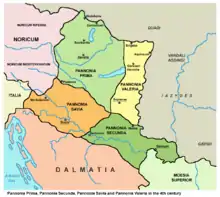 Pannonia in the 4th century
Pannonia in the 4th century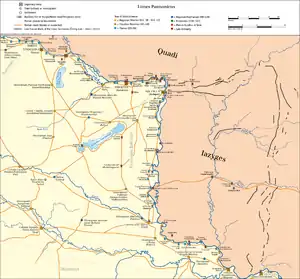 Pannonia with Constantine I "limes" in 330 AD
Pannonia with Constantine I "limes" in 330 AD
Loss
In the 4th century, the Romans (especially under Valentinian I) fortified the villas and relocated barbarians to the border regions. In 358 they won a great victory over the Sarmatians, but raids didn't stop. In 401 the Visigoths fled to the province from the Huns, and the border guarding peoples fled to Italia from them, but were beaten by Uldin in exchange for the transferring of Eastern Pannonia. In 433 Rome completely handed over the territory to Attila for the subjugation of the Burgundians attacking Gaul.[42]
After Roman rule
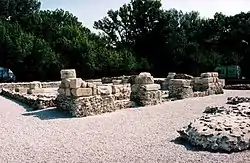
During the Migration Period in the 5th century, some parts of Pannonia were ceded to the Huns in 433 by Flavius Aetius, the magister militum of the Western Roman Empire.[43] After the collapse of the Hunnic empire in 454, large numbers of Ostrogoths were settled by Emperor Marcian in the province as foederati. The Eastern Roman Empire controlled southern parts of Pannonia in the 6th century, during the reign of Justinian I. The Byzantine province of Pannonia with its capital at Sirmium was temporarily restored, but it included only a small southeastern part of historical Pannonia.
Afterwards, it was again invaded by the Avars in the 560s, and the Slavs, who first may settled c. 480s but became independent only from the 7th century. In 790s, it was invaded by the Franks, who used the name "Pannonia" to designate the newly formed frontier province, the March of Pannonia. The term Pannonia was also used for Slavic polity like Lower Pannonia that was vassal to the Frankish Empire.
Cities and auxiliary forts
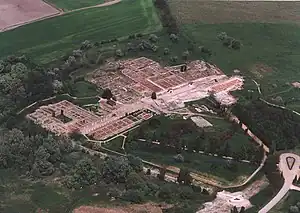
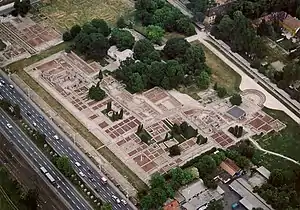
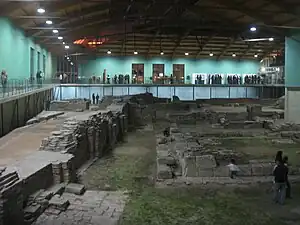
The native settlements consisted of pagi (cantons) containing a number of vici (villages), the majority of the large towns being of Roman origin. The cities and towns in Pannonia were:
Now in Austria:
Now in Bosnia and Herzegovina:
Now in Croatia:
- Ad Novas (Zmajevac)
- Andautonia (Ščitarjevo)
- Aqua Viva (Petrijanec)
- Aquae Balisae (Daruvar)
- Certissa (Đakovo)
- Cibalae (Vinkovci)
- Cornacum (Sotin)
- Cuccium (Ilok)
- Iovia or Iovia Botivo (Ludbreg)
- Marsonia (Slavonski Brod)
- Mursa (Osijek)
- Siscia (Sisak)
- Teutoburgium (Dalj)
Now in Hungary:
- Ad Flexum (Mosonmagyaróvár)
- Ad Mures (Ács)
- Ad Statuas (Vaspuszta)
- Ad Statuas (Várdomb)
- Alisca (Szekszárd)
- Alta Ripa (Tolna)
- Aquincum (Óbuda, Budapest)
- Arrabona (Győr)
- Brigetio (Szőny)
- Caesariana (Baláca)
- Campona (Nagytétény)
- Cirpi (Dunabogdány)
- Contra-Aquincum (Budapest)
- Contra Constantiam (Dunakeszi)
- Gorsium-Herculia (Tác)
- Intercisa (Dunaújváros)
- Iovia (Szakcs)
- Lugio (Dunaszekcső)
- Lussonium (Dunakömlőd)
- Matrica (Százhalombatta)
- Morgentianae (Tüskevár (?))
- Mursella (Mórichida)
- Quadrata (Lébény)
- Sala (Zalalövő)
- Savaria (Szombathely)
- Scarbantia (Sopron)
- Solva (Esztergom)
- Sopianae (Pécs)
- Ulcisia Castra (Szentendre)
- Valcum (Fenékpuszta)
Now in Serbia:
- Acumincum (Stari Slankamen)
- Ad Herculae (Čortanovci)
- Bassianae (Donji Petrovci)
- Bononia (Banoštor)
- Burgenae (Novi Banovci)
- Cusum (Petrovaradin)
- Graio (Sremska Rača)
- Onagrinum (Begeč)
- Rittium (Surduk)
- Sirmium (Sremska Mitrovica)
- Taurunum (Zemun)
Now in Slovakia:
Now in Slovenia:
Economy
The country was fairly productive, especially after the great forests had been cleared by Probus and Galerius. Before that time, timber had been one of its most important exports. Its chief agricultural products were oats and barley, from which the inhabitants brewed a kind of beer named sabaea. Vines and olive trees were little cultivated. Pannonia was also famous for its breed of hunting dogs. Although no mention is made of its mineral wealth by the ancients, it is probable that it contained iron and silver mines.
Slavery
Slavery held a less important role in Pannonia's economy than in earlier established provinces. Rich civilians had domestic slaves do the housework while soldiers who had been awarded with land had their slaves cultivate it. Slaves worked in workshops primarily in western cities for rich industrialist.[17] In Aquincum, they were freed in a short time.[38]
Religion
Pannonia had sanctuaries for Jupiter, Juno and Minerva, official deities of empire, and also for old Celtic deities. In Aquincum there was one for the mother goddess. The imperial cult was also present. In addition, Judaism and eastern mystery cults also appeared, the latter centered around Mithra, Isis, Anubis and Serapis.[38]
Christianity began to spread inside the province in the 2nd century. Its popularity didn't decrease even during the big persecutions in the late 3rd century. In the 4th century, basilicas and funeral chapels were built. We know of the Church of Saint Quirinus in Savaria and numerous early Christian memorials from Aquincum, Sopianae, Fenékpuszta, and Arian Christian ones from Csopak.[38]
Legacy
The ancient name Pannonia is retained in the modern term Pannonian plain.
References
- Haywood, Anthony; Sieg, Caroline (2010). Vienna, Anthony Haywood, Caroline (CON) Sieg, Lonely Planet Vienna, 2010, page 21. ISBN 9781741790023.
- Goodrich, Samuel Griswold (1835). "The third book of history: containing ancient history in connection with ancient geography, Samuel Griswold Goodrich, Jenks, Palmer, 1835, page 111".
- Lengyel, Alfonz; Radan, George T.; Barkóczi, László (1980). The Archaeology of Roman Pannonia, Alfonz Lengyel, George T. Radan, University Press of Kentucky, 1980, page 247. ISBN 9789630518864.
- Laszlovszky, J¢Zsef; Szab¢, P'ter (January 2003). People and nature in historical perspective, Péter Szabó, Central European University Press, 2003, page 144. ISBN 9789639241862.
- "Historical outlook: a journal for readers, students and teachers of history, Том 9, American Historical Association, National Board for Historical Service, National Council for the Social Studies, McKinley Publishing Company, 1918, page 194". 1918.
- Pierce, Edward M. (1869). "THE COTTAGE CYCLOPEDIA OF HISTORY AND BIOGRAPHY, ED.M.PIERCE, 1869, page 915".
- J. Pokorny, Indogermanisches etymologisches Wörterbuch, No. 1481 Archived 2011-06-12 at the Wayback Machine
- Pliny, iv.25
- The threatening nature of the pathless woodland in Pliny is explored by Klaus Sallmann, "Reserved for Eternal Punishment: The Elder Pliny's View of Free Germania (HN. 16.1–6)" The American Journal of Philology 108.1 (Spring 1987:108–128) pp 118ff.
- Pliny xvi.2
- Compare the inaccessible Carbonarius Saltus west of the Rhine
- Florus, ii.30.27.
- Trogmayer 1980, p. 81.
- Barkóczi 1980, p. 86.
- Alföldi 2004, p. 13.
- Elekes, Lederer & Székely 1961, p. 12.
- Elekes, Lederer & Székely 1961, p. 13.
- Alföldi 2004, p. 15.
- Alföldi 2004, p. 16.
- Alföldi 2004, p. 14.
- Barkóczi 1980, p. 90.
- Barkóczi 1980, p. 87.
- Tóth 1983, p. 19.
- Barkóczi 1980, p. 88.
- Tóth 1983, p. 20.
- Alföldi 2004, p. 16-17.
- Thayer, Bill (2 March 2023). "The Res Gestae of Augustus". LacusCurtius.
- Boren 1977, p. 124.
- Barkóczi 1980, p. 89.
- Eck, Werner (2007). The Age of Augustus. Translated by Schneider, Deborah L. (Second ed.). Blackwell Publishing (now Wiley-Blackwell). p. 128.
- Tóth 1983, p. 21.
- Barkóczi 1980, p. 91.
- Boren 1977, p. 160-161.
- Oltean, Ioana A. (2007). Dacia: Landscape, colonisation and romanisation. Abingdon: Routledge. p. 49. ISBN 978-0-203-94583-4.
- Pannonia — United Nations of Roma Victrix
- Barkóczi 1980, p. 92.
- Marquez-Grant, Nicholas; Fibiger, Linda (21 March 2011). The Routledge Handbook of Archaeological Human Remains and Legislation, Taylor & Francis, page 381. ISBN 9781136879562.
- Elekes, Lederer & Székely 1961, p. 14.
- Elekes, Lederer & Székely 1961, p. 15.
- Petruska 1983, p. 301.
- Petruska 1983, p. 302.
- Elekes, Lederer & Székely 1961, p. 18.
- Harvey, Bonnie C. (2003). Attila, the Hun – Google Knihy. ISBN 0-7910-7221-5. Retrieved 2018-10-17.
Sources
- Curta, Florin (2001). The Making of the Slavs: History and Archaeology of the Lower Danube Region, c. 500–700. Cambridge: Cambridge University Press. ISBN 9781139428880.
- Curta, Florin (2006). Southeastern Europe in the Middle Ages, 500–1250. Cambridge: Cambridge University Press.
- Given, John (2014). The Fragmentary History of Priscus. Merchantville, New Jersey: Evolution Publishing. ISBN 9781935228141.
- Gračanin, Hrvoje (2006). "The Huns and South Pannonia". Byzantinoslavica. 64: 29–76.
- Gračanin, Hrvoje (2015). "Late Antique Dalmatia and Pannonia in Cassiodorus' Variae". Povijesni prilozi. 49: 9–80.
- Gračanin, Hrvoje (2016). "Late Antique Dalmatia and Pannonia in Cassiodorus' Variae (Addenda)". Povijesni prilozi. 50: 191–198.
- Janković, Đorđe (2004). "The Slavs in the 6th Century North Illyricum". Гласник Српског археолошког друштва. 20: 39–61.
- Mirković, Miroslava B. (2017). Sirmium: Its History from the First Century AD to 582 AD. Novi Sad: Center for Historical Research.
- Mócsy, András (2014) [1974]. Pannonia and Upper Moesia: A History of the Middle Danube Provinces of the Roman Empire. New York: Routledge. ISBN 9781317754251.
- Popović, Radomir V. (1996). Le Christianisme sur le sol de l'Illyricum oriental jusqu'à l'arrivée des Slaves. Thessaloniki: Institute for Balkan Studies. ISBN 9789607387103.
- Várady, László (1969). Das Letzte Jahrhundert Pannoniens (376–476). Amsterdam: Verlag Adolf M. Hakkert.
- Whitby, Michael (1988). The Emperor Maurice and his Historian: Theophylact Simocatta on Persian and Balkan warfare. Oxford: Clarendon Press. ISBN 978-0-19-822945-2.
- Wozniak, Frank E. (1981). "East Rome, Ravenna and Western Illyricum: 454-536 A.D." Historia: Zeitschrift für Alte Geschichte. 30 (3): 351–382.
- Zeiller, Jacques (1918). Les origines chrétiennes dans les provinces danubiennes de l'Empire romain. Paris: E. De Boccard.
- Elekes, Lajos; Lederer, Emma; Székely, György (1961). Magyarország története [History of Hungary] (PDF). Vol. I. Budapest: Tankönyvkiadó.
- Petruska, Magdolna (1983). "A Danuvius partján" [On the shore of the Danuvius]. In Gyulás, Istvánné (ed.). Az antik Róma napjai [The days of ancient Rome]. Tankönyvkiadó.
- Alföldi, András (2004). Patay-Horváth, András; Forisek, Péter (eds.). Magyarország népei és a Római Birodalom — Keletmagyarország a római korban. Attraktor. ISBN 963-9580-05-8.
- Boren, Henry C. (1977). Rabb, Theodore K. (ed.). Roman Society: A Social, Economic, and Cultural History. Toronto: University of North Carolina at Chapel Hill. ISBN 0-669-84681-3.
- Marczali, Henrik (1911). Magyarország története. Vol. 1. Budapest: Athenaum Irodalmi és Nyomadi Részvénytársulat.
- Benda, Kálmán; Solymosi, László, eds. (1983). Magyarország történeti kronológiája [Historical chronology of Hungary] (PDF). Vol. 1. A kezdetektől 1526-ig. Budapest: Akadémiai Kiadó. ISBN 963 05 3182 8.
- Kovács, Tibor. "őskőkor-vaskor". In Benda & Solymosi (1983).
- Tóth, István. "római kor". In Benda & Solymosi (1983).
- Lengyel, Alfonz; Radan, George T., eds. (1980). The archaeology of Roman Pannonia (PDF). Lexington, Budapest: University Press of Kentucky, Akadémiai Kiadó. ISBN 0-8131-1370-9.
- Trogmayer, Ottó. "Pannonia before the Roman conquest". In Lengyel & Radan (1980).
- Barkóczi, László. "History of Pannonia". In Lengyel & Radan (1980).
Further reading
External links
- . Encyclopædia Britannica. Vol. 20 (11th ed.). 1911. p. 680.
- "Pannonia". Encyclopædia Britannica (online ed.). 29 March 2018.
- Pannonia map
- Pannonia map
- Aerial photography: Gorsium - Tác - Hungary
- Aerial photography: Aquincum - Budapest - Hungary
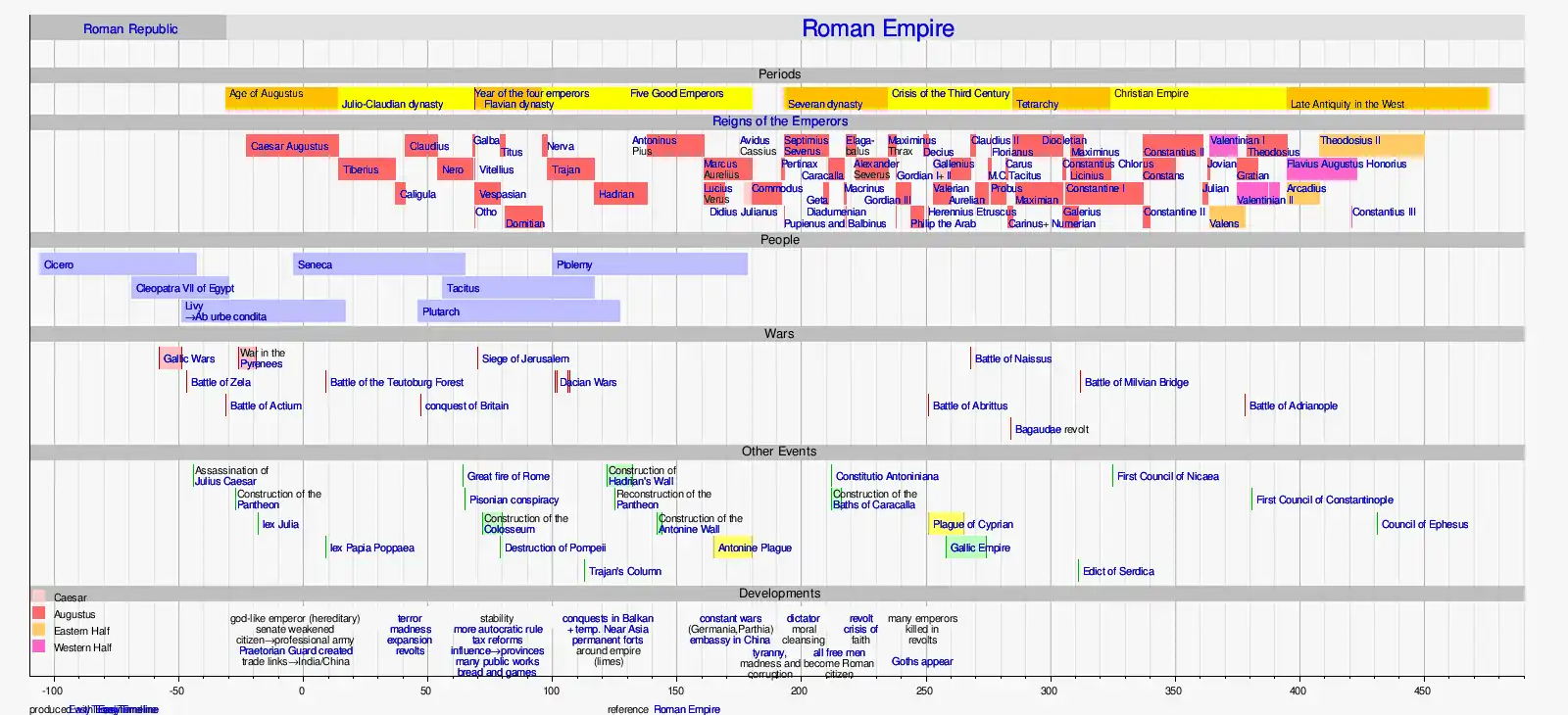 |
| Notes:
|
